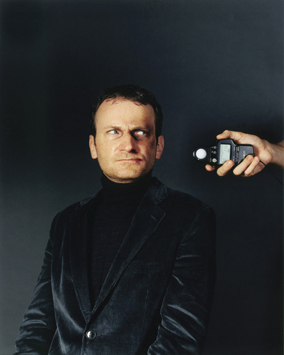PHOTO ESSAY
Buck Shot
The portrait photography of Chris Buck
By Matthew McKinnon
March 21, 2006
 Chris Buck, Esquire, 2004. All photos courtesy of Chris Buck. |
In his novel Mao II (1991), Don DeLillo describes the psychological sparring of a photographer and her famous subject, a reclusive writer who has avoided having his picture taken for 30 years. Brita Nilsson draws Bill Gray out from his shadows. She questions and cajoles him, exchanging bits of herself for pieces of him: “She watched him surrender his crisp gaze to a softening, a bright-eyed fear that seemed to tunnel out of childhood. It had the starkness of a last prayer. She worked to get at it. His face was drained and slack, coming into flatness, into black and white, cracked lips and flaring brows, age lines that hinge the chin, old bafflements and regrets. She moved in closer and refocused, she shot and shot, and he stood there looking into the lens, soft eyes shining.”
It is an exquisite scene, and a crisp telling of the challenge of portrait photography: to capture a greater truth about the person being photographed than what is obvious to the naked eye. “Different portraits solve the problem in different ways,” says Chris Buck, a photographer who has spent close to two decades shooting celebrity faces for A-list clients in Canada and the United States. “Sometimes it’s very visual, like a great location or great lighting. Sometimes it’s something that has an implied meaning, through a prop or a context. Sometimes it’s a simple connection through a facial expression.”
This 2004 self-portrait for Esquire is classic Buck — equal parts clever and damaged. He chose the black-and-blue set-up from a list of oddball ideas that he has maintained for years, and puts to use when the rare opportunity strikes. (That is, when he finds agreeable subjects. See: Missy Elliott in silver face paint, Billy Bob Thornton peeing on a backdrop.) “I wanted to do what I wished people would do for me,” he says. “Often times I’m frustrated that people won’t go further with me.”
![]() CBC
does not endorse and is not responsible
for the content of external sites
- links will open in new window.
CBC
does not endorse and is not responsible
for the content of external sites
- links will open in new window.
More from this Author
Matthew McKinnon
- South London calling
- This is the year of dubstep. Which means what, exactly?
- Kick out the jams
- 2006: the year in music
- The Smackdown
- This week: Is U2 over?
- Can't Stop, Won't Stop
- The unretirement of Jay-Z
- Twos of a Kind
- François Brunelle’s look-alike portraits


